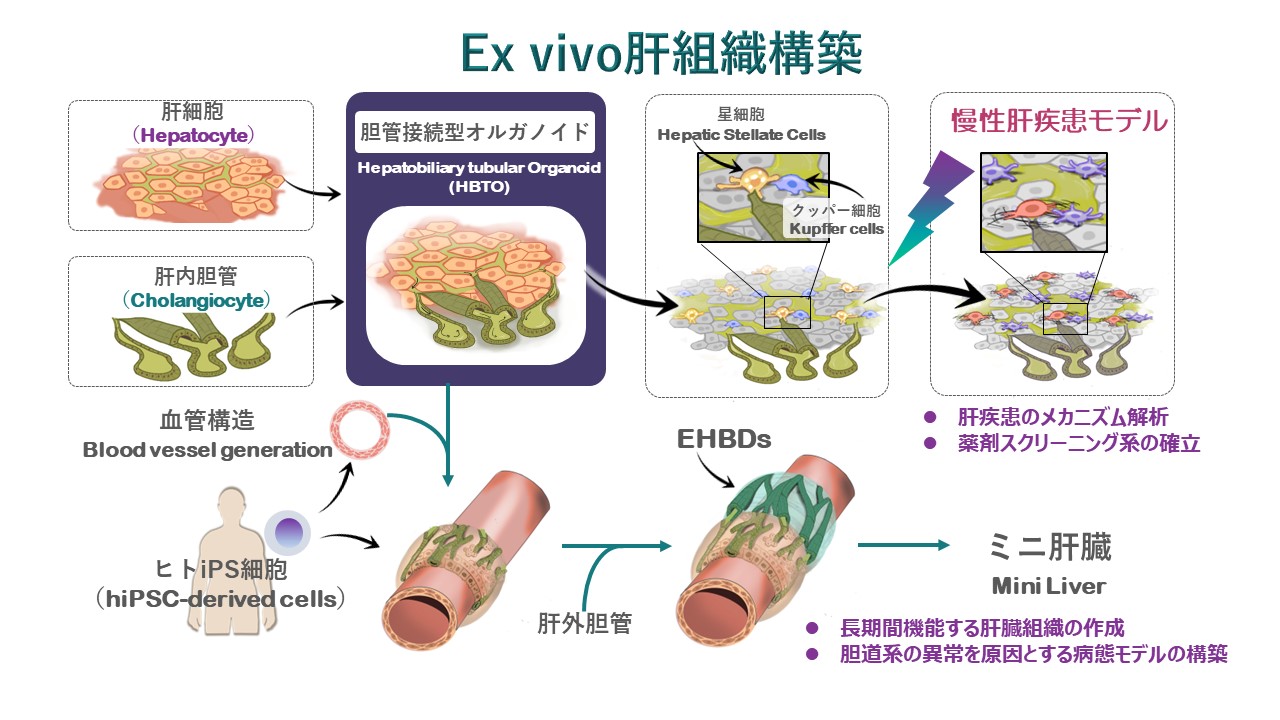ヒトiPS細胞を活用した肝臓組織のEx vivo再構築
我々は、発生における肝臓の3次元的な組織構造の形成プロセスやその制御メカニズムの解析を行ってきた。その知見をもとに、生体内に近い機能と構造を持った肝臓オルガノイドをヒトiPS細胞から作成することを試みている。特に胆管や血管といった管状の組織構造と肝細胞の空間配置を再現することで、複雑な臓器内部の構造を再構築し、将来的には生体内に近い構造と機能を持ったミニ肝臓の創出を目指している。
また、我々が独自に開発した胆管接続型の肝臓オルガノイドを用いた肝疾患モデルの構築も進めている。肝臓は高い再生能力を有しているが、慢性的な障害に晒されると、やがて再生能力を失い、組織の線維化から肝硬変へと病態が進行する。In vitro疾患モデルを用いた解析によって、肝細胞、胆管、自律神経などの組織間相互作用を明らかにし、将来的には、線維化の解消や肝細胞増殖を促進する方法を見出すことで、慢性肝疾患に対する治療法開発を目指している。
Our group studies liver development and regeneration through mice observation and utilizing human iPS cells. We are particularly interested in how pivotal liver structures like the hepatic cord, bile ducts, blood vessels, and autonomic nerve network are formed during organogenesis. By applying our basic research knowledge, we aim to generate a novel liver organoid that emulates actual three-dimensional (3D) liver tissue structures, such as the bile excretion system resembling natural liver functions. In addition, we also establish a chronic liver injury model using our novel hepatobiliary tubular organoid (HBTO) to understand how cellular interactions within the tissue are affected by hepatic damage and identify molecular targets for ameliorating hepatic diseases.
胆汁輸送を再現した肝臓オルガノイドの開発に成功
Generation of functional liver organoids on combining hepatocytes and cholangiocytes with hepatobiliary connections ex vivo
ヒトiPS細胞由来の肝臓オルガノイド内部に胆管構造を再現 ――ヒト臓器創出技術の開発やヒト胆道疾患モデルの構築に期待――
Generation of human iPSC-derived 3D bile duct within liver organoid by incorporating human iPSC-derived blood vessel
- "胎盤由来因子"を活用することにより ヒトiPS細胞由来のミニ肝臓を成長させることに成功! ――ヒト臓器創出技術への応用に期待――
- Placenta-derived factors contribute to human iPSC-liver organoid growth
- β-adrenergic receptor agonist promotes ductular expansion during 3,5-diethoxycarbonyl-1,4-dihydrocollidine-induced chronic liver injury.
- 総説/review
Generation of in vivo-like multicellular liver organoids by mimicking developmental processes: A review - Lineage plasticity and reprogramming of epithelial cells during tissue injury and regeneration -lessons from the lineage plasticity of hepatocytes and cholangiocytes induced by liver injury–


